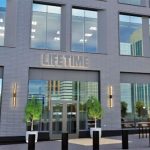In a new report from PeopleForBikes and the Alliance for Biking & Walking, Protected Bike Lanes Mean Business, entrepreneurs and business leaders from major U.S. cities explain how protected bike lanes – on-street lanes that are physically separated from automobile traffic by curbs, planters, parked cars or posts – has meant big benefits for their companies.
The report combines this original reporting with an overview of the latest academic and technical research to find changes associated with four mega-trends:
Companies scramble to attract the most skilled Millennials and Gen X-ers, who increasingly prefer downtown jobs and commutes that don’t involve a car. Employers say their headhunters get a competitive edge by locating in areas with great biking networks.
Among Americans between the ages of 16 and 35, car travel is down by 23 percent while bicycle trips are up by 24 percent. Venture capital investment data show that startups are now more likely to locate within cities rather than in suburbs – so as to better attract and retain pro-bike Millennial and Gen X employees.
Americans are flocking to urban areas, congesting city streets. By making biking appeal to more people, protected lanes increase access to fast-developing neighborhoods without the negative impact of additional auto traffic.
Studies show that homes near bicycle infrastructure appreciate in value more than equivalent houses away from bike lanes. In Indianapolis, proximity to a bike route increases your home price by an average of 11 percent.
With health care costs at an all-time high, companies are scrambling to encourage active living. Employers benefit when more employees find it pleasant to bike to the office.
People who ride their bike to work have up to 55 percent lower healthcare costs, use 32 percent fewer sick days, and increase productivity by up to 52 percent.
In urban shopping districts where space is at a high premium, the most lucrative customers are those who stop by often and have a small parking footprint. Increasingly, shop owners are looking for ways to encourage biking.
Studies in California, Oregon, Ontario, Australia, New Zealand and Ireland all found that people who arrive to a shop by bike spend less per visit but return more often, resulting in similar overall spending per month but far lower parking needs. In a Melbourne study, each square foot of auto parking generated 19 cents in retail revenue, while a square foot of bike parking led to 69 cents.
“These data and testimonials from business leaders make it very clear that, as a nation, we need to prioritize investments in 21st century transportation networks where bicycling plays a key role,” said Jeffrey Miller, President / CEO of the Alliance for Biking & Walking. “This is an especially timely finding given that Congress is beginning work on a new federal transportation bill. Protected bike lanes help businesses thrive – in today’s world and in the context of our nation’s shifting demographics.”
“More and more communities across the country are investing in protected bike lanes – and for good reason. These lanes are part of the solution to getting small and large businesses back on their feet,” said Martha Roskowski, PeopleForBikes vice president of local innovation. “Just in the past two years, we’ve seen the total mileage of protected bike lanes in the U.S. nearly double, and we expect this growth to continue.”
The full report is at this link: Protected Bike Lanes Mean Business.















